Ethical Dimensions of Physician-Assisted Suicide: A Detailed Analysis
VerifiedAdded on 2023/05/27
|9
|1980
|234
Essay
AI Summary
This essay provides an analysis of physician-assisted suicide (PAS), examining various ethical considerations, legal perspectives, and societal impacts. It discusses the arguments for and against PAS, referencing international legalizations, concerns regarding vulnerable populations, and the role of the Hippocratic Oath. The essay explores the potential for abuse, the shift in doctor-patient relationships, and the risk to marginalized groups. It also highlights alternative solutions like palliative care and concludes by emphasizing the need to protect the dignity and equality of human life. This paper provides a comprehensive overview of the complex issues surrounding PAS, considering both advocacy and opposition viewpoints.
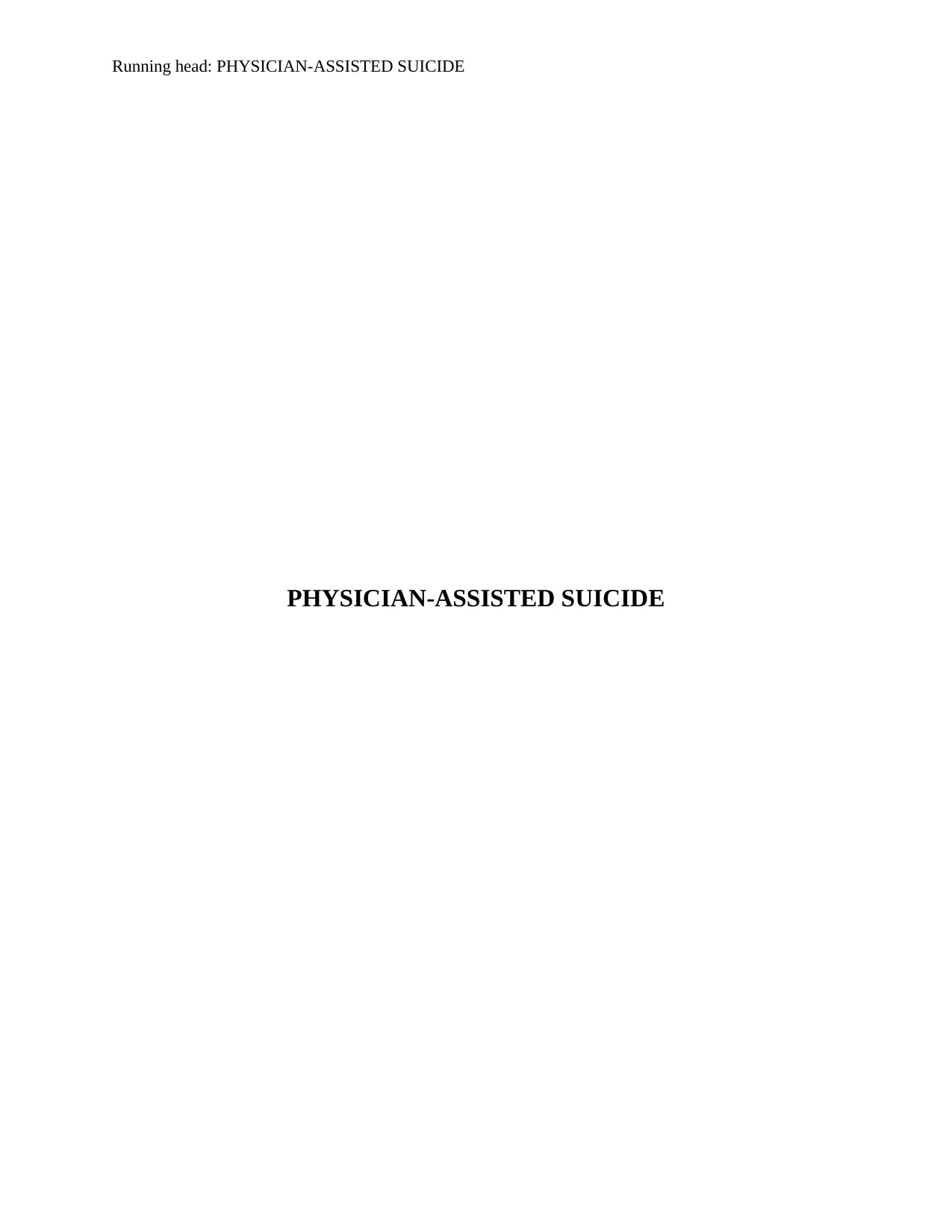
Running head: PHYSICIAN-ASSISTED SUICIDE
PHYSICIAN-ASSISTED SUICIDE
PHYSICIAN-ASSISTED SUICIDE
Paraphrase This Document
Need a fresh take? Get an instant paraphrase of this document with our AI Paraphraser
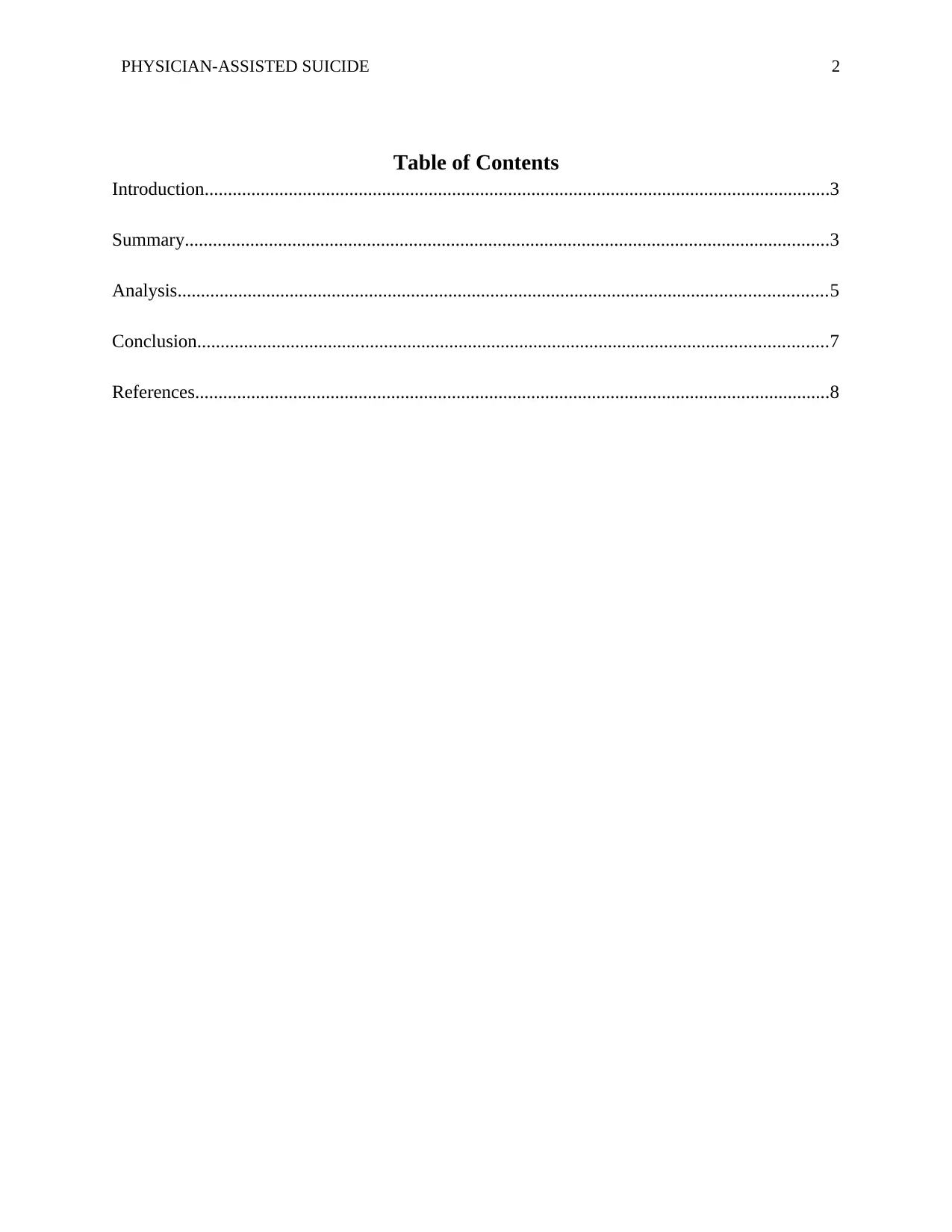
PHYSICIAN-ASSISTED SUICIDE 2
Table of Contents
Introduction......................................................................................................................................3
Summary..........................................................................................................................................3
Analysis...........................................................................................................................................5
Conclusion.......................................................................................................................................7
References........................................................................................................................................8
Table of Contents
Introduction......................................................................................................................................3
Summary..........................................................................................................................................3
Analysis...........................................................................................................................................5
Conclusion.......................................................................................................................................7
References........................................................................................................................................8
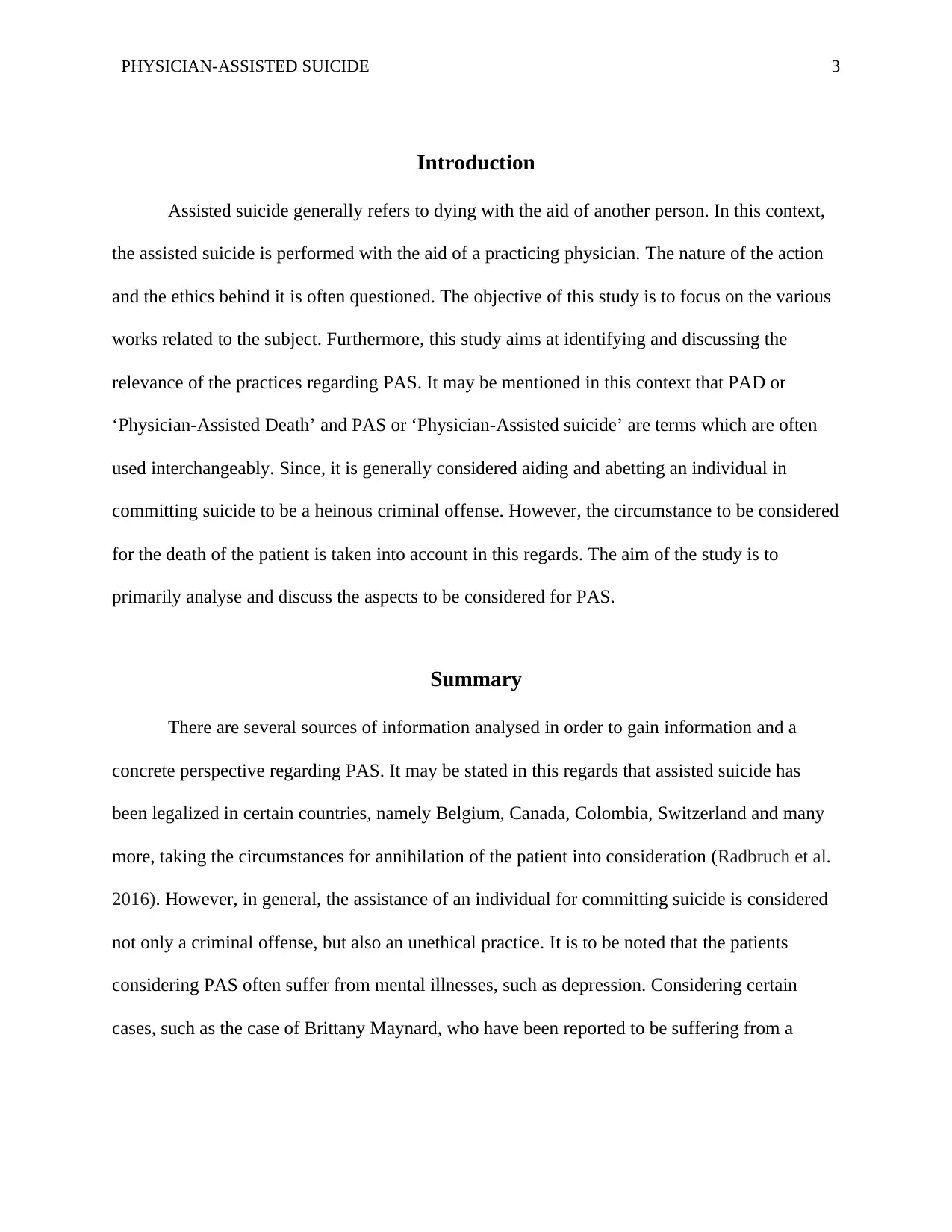
PHYSICIAN-ASSISTED SUICIDE 3
Introduction
Assisted suicide generally refers to dying with the aid of another person. In this context,
the assisted suicide is performed with the aid of a practicing physician. The nature of the action
and the ethics behind it is often questioned. The objective of this study is to focus on the various
works related to the subject. Furthermore, this study aims at identifying and discussing the
relevance of the practices regarding PAS. It may be mentioned in this context that PAD or
‘Physician-Assisted Death’ and PAS or ‘Physician-Assisted suicide’ are terms which are often
used interchangeably. Since, it is generally considered aiding and abetting an individual in
committing suicide to be a heinous criminal offense. However, the circumstance to be considered
for the death of the patient is taken into account in this regards. The aim of the study is to
primarily analyse and discuss the aspects to be considered for PAS.
Summary
There are several sources of information analysed in order to gain information and a
concrete perspective regarding PAS. It may be stated in this regards that assisted suicide has
been legalized in certain countries, namely Belgium, Canada, Colombia, Switzerland and many
more, taking the circumstances for annihilation of the patient into consideration (Radbruch et al.
2016). However, in general, the assistance of an individual for committing suicide is considered
not only a criminal offense, but also an unethical practice. It is to be noted that the patients
considering PAS often suffer from mental illnesses, such as depression. Considering certain
cases, such as the case of Brittany Maynard, who have been reported to be suffering from a
Introduction
Assisted suicide generally refers to dying with the aid of another person. In this context,
the assisted suicide is performed with the aid of a practicing physician. The nature of the action
and the ethics behind it is often questioned. The objective of this study is to focus on the various
works related to the subject. Furthermore, this study aims at identifying and discussing the
relevance of the practices regarding PAS. It may be mentioned in this context that PAD or
‘Physician-Assisted Death’ and PAS or ‘Physician-Assisted suicide’ are terms which are often
used interchangeably. Since, it is generally considered aiding and abetting an individual in
committing suicide to be a heinous criminal offense. However, the circumstance to be considered
for the death of the patient is taken into account in this regards. The aim of the study is to
primarily analyse and discuss the aspects to be considered for PAS.
Summary
There are several sources of information analysed in order to gain information and a
concrete perspective regarding PAS. It may be stated in this regards that assisted suicide has
been legalized in certain countries, namely Belgium, Canada, Colombia, Switzerland and many
more, taking the circumstances for annihilation of the patient into consideration (Radbruch et al.
2016). However, in general, the assistance of an individual for committing suicide is considered
not only a criminal offense, but also an unethical practice. It is to be noted that the patients
considering PAS often suffer from mental illnesses, such as depression. Considering certain
cases, such as the case of Brittany Maynard, who have been reported to be suffering from a
⊘ This is a preview!⊘
Do you want full access?
Subscribe today to unlock all pages.

Trusted by 1+ million students worldwide
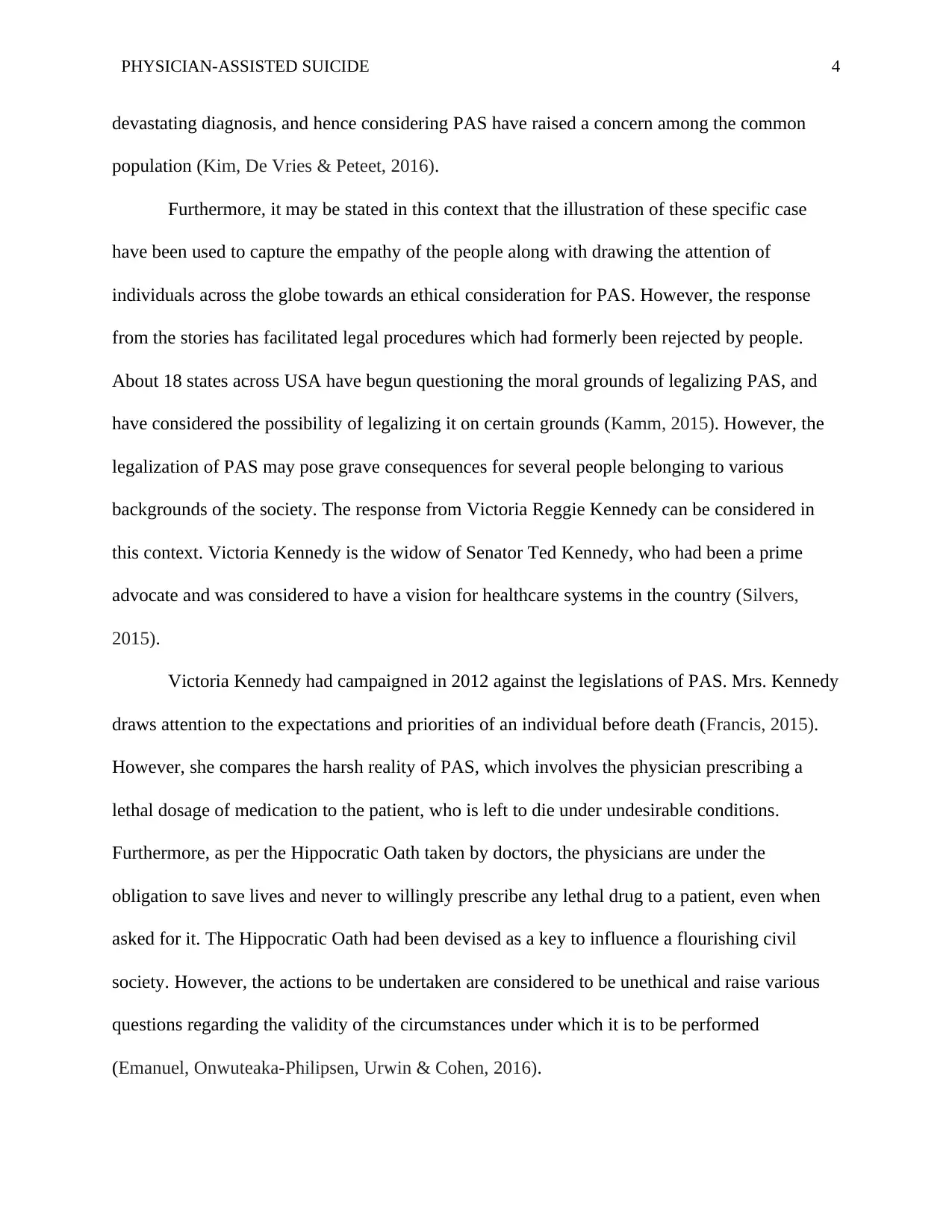
PHYSICIAN-ASSISTED SUICIDE 4
devastating diagnosis, and hence considering PAS have raised a concern among the common
population (Kim, De Vries & Peteet, 2016).
Furthermore, it may be stated in this context that the illustration of these specific case
have been used to capture the empathy of the people along with drawing the attention of
individuals across the globe towards an ethical consideration for PAS. However, the response
from the stories has facilitated legal procedures which had formerly been rejected by people.
About 18 states across USA have begun questioning the moral grounds of legalizing PAS, and
have considered the possibility of legalizing it on certain grounds (Kamm, 2015). However, the
legalization of PAS may pose grave consequences for several people belonging to various
backgrounds of the society. The response from Victoria Reggie Kennedy can be considered in
this context. Victoria Kennedy is the widow of Senator Ted Kennedy, who had been a prime
advocate and was considered to have a vision for healthcare systems in the country (Silvers,
2015).
Victoria Kennedy had campaigned in 2012 against the legislations of PAS. Mrs. Kennedy
draws attention to the expectations and priorities of an individual before death (Francis, 2015).
However, she compares the harsh reality of PAS, which involves the physician prescribing a
lethal dosage of medication to the patient, who is left to die under undesirable conditions.
Furthermore, as per the Hippocratic Oath taken by doctors, the physicians are under the
obligation to save lives and never to willingly prescribe any lethal drug to a patient, even when
asked for it. The Hippocratic Oath had been devised as a key to influence a flourishing civil
society. However, the actions to be undertaken are considered to be unethical and raise various
questions regarding the validity of the circumstances under which it is to be performed
(Emanuel, Onwuteaka-Philipsen, Urwin & Cohen, 2016).
devastating diagnosis, and hence considering PAS have raised a concern among the common
population (Kim, De Vries & Peteet, 2016).
Furthermore, it may be stated in this context that the illustration of these specific case
have been used to capture the empathy of the people along with drawing the attention of
individuals across the globe towards an ethical consideration for PAS. However, the response
from the stories has facilitated legal procedures which had formerly been rejected by people.
About 18 states across USA have begun questioning the moral grounds of legalizing PAS, and
have considered the possibility of legalizing it on certain grounds (Kamm, 2015). However, the
legalization of PAS may pose grave consequences for several people belonging to various
backgrounds of the society. The response from Victoria Reggie Kennedy can be considered in
this context. Victoria Kennedy is the widow of Senator Ted Kennedy, who had been a prime
advocate and was considered to have a vision for healthcare systems in the country (Silvers,
2015).
Victoria Kennedy had campaigned in 2012 against the legislations of PAS. Mrs. Kennedy
draws attention to the expectations and priorities of an individual before death (Francis, 2015).
However, she compares the harsh reality of PAS, which involves the physician prescribing a
lethal dosage of medication to the patient, who is left to die under undesirable conditions.
Furthermore, as per the Hippocratic Oath taken by doctors, the physicians are under the
obligation to save lives and never to willingly prescribe any lethal drug to a patient, even when
asked for it. The Hippocratic Oath had been devised as a key to influence a flourishing civil
society. However, the actions to be undertaken are considered to be unethical and raise various
questions regarding the validity of the circumstances under which it is to be performed
(Emanuel, Onwuteaka-Philipsen, Urwin & Cohen, 2016).
Paraphrase This Document
Need a fresh take? Get an instant paraphrase of this document with our AI Paraphraser
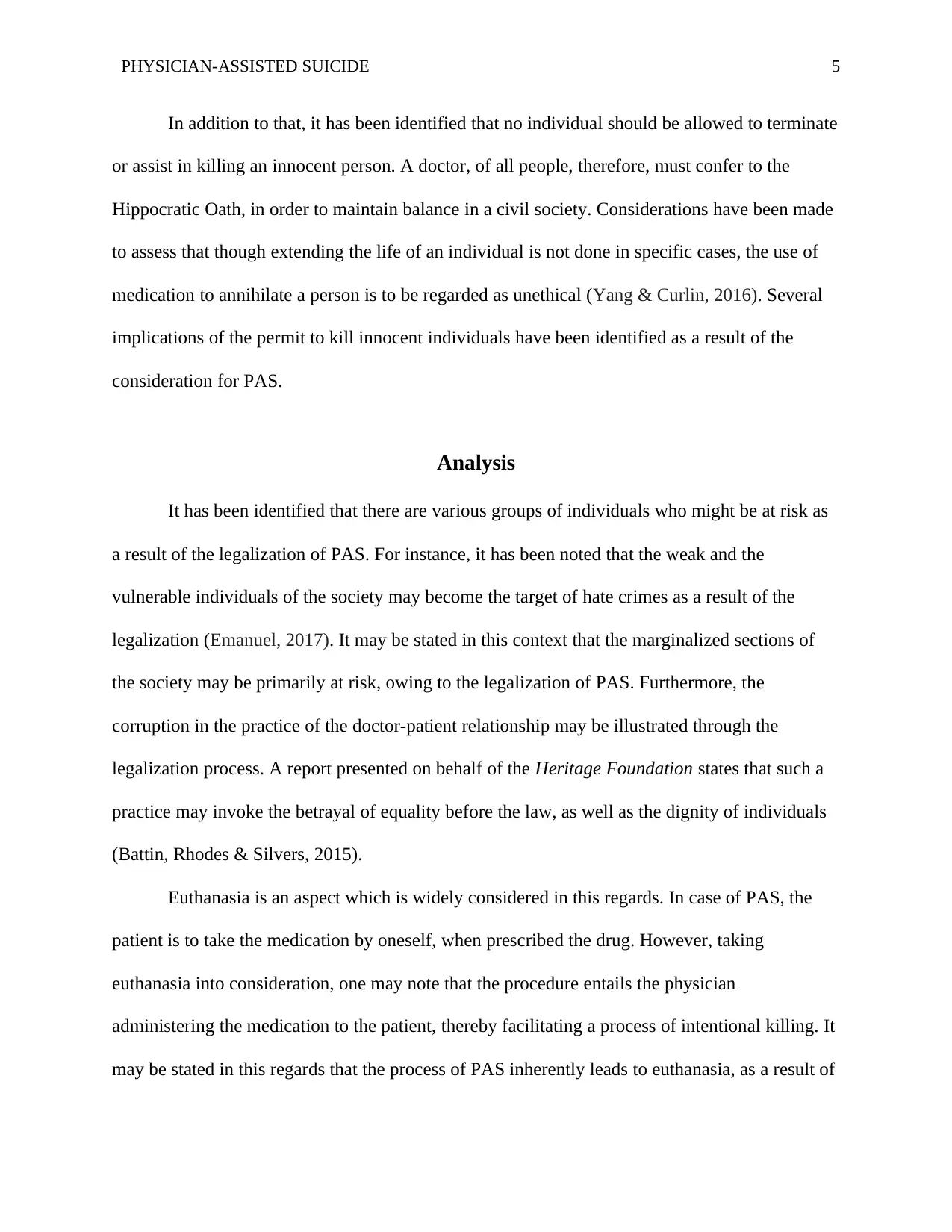
PHYSICIAN-ASSISTED SUICIDE 5
In addition to that, it has been identified that no individual should be allowed to terminate
or assist in killing an innocent person. A doctor, of all people, therefore, must confer to the
Hippocratic Oath, in order to maintain balance in a civil society. Considerations have been made
to assess that though extending the life of an individual is not done in specific cases, the use of
medication to annihilate a person is to be regarded as unethical (Yang & Curlin, 2016). Several
implications of the permit to kill innocent individuals have been identified as a result of the
consideration for PAS.
Analysis
It has been identified that there are various groups of individuals who might be at risk as
a result of the legalization of PAS. For instance, it has been noted that the weak and the
vulnerable individuals of the society may become the target of hate crimes as a result of the
legalization (Emanuel, 2017). It may be stated in this context that the marginalized sections of
the society may be primarily at risk, owing to the legalization of PAS. Furthermore, the
corruption in the practice of the doctor-patient relationship may be illustrated through the
legalization process. A report presented on behalf of the Heritage Foundation states that such a
practice may invoke the betrayal of equality before the law, as well as the dignity of individuals
(Battin, Rhodes & Silvers, 2015).
Euthanasia is an aspect which is widely considered in this regards. In case of PAS, the
patient is to take the medication by oneself, when prescribed the drug. However, taking
euthanasia into consideration, one may note that the procedure entails the physician
administering the medication to the patient, thereby facilitating a process of intentional killing. It
may be stated in this regards that the process of PAS inherently leads to euthanasia, as a result of
In addition to that, it has been identified that no individual should be allowed to terminate
or assist in killing an innocent person. A doctor, of all people, therefore, must confer to the
Hippocratic Oath, in order to maintain balance in a civil society. Considerations have been made
to assess that though extending the life of an individual is not done in specific cases, the use of
medication to annihilate a person is to be regarded as unethical (Yang & Curlin, 2016). Several
implications of the permit to kill innocent individuals have been identified as a result of the
consideration for PAS.
Analysis
It has been identified that there are various groups of individuals who might be at risk as
a result of the legalization of PAS. For instance, it has been noted that the weak and the
vulnerable individuals of the society may become the target of hate crimes as a result of the
legalization (Emanuel, 2017). It may be stated in this context that the marginalized sections of
the society may be primarily at risk, owing to the legalization of PAS. Furthermore, the
corruption in the practice of the doctor-patient relationship may be illustrated through the
legalization process. A report presented on behalf of the Heritage Foundation states that such a
practice may invoke the betrayal of equality before the law, as well as the dignity of individuals
(Battin, Rhodes & Silvers, 2015).
Euthanasia is an aspect which is widely considered in this regards. In case of PAS, the
patient is to take the medication by oneself, when prescribed the drug. However, taking
euthanasia into consideration, one may note that the procedure entails the physician
administering the medication to the patient, thereby facilitating a process of intentional killing. It
may be stated in this regards that the process of PAS inherently leads to euthanasia, as a result of
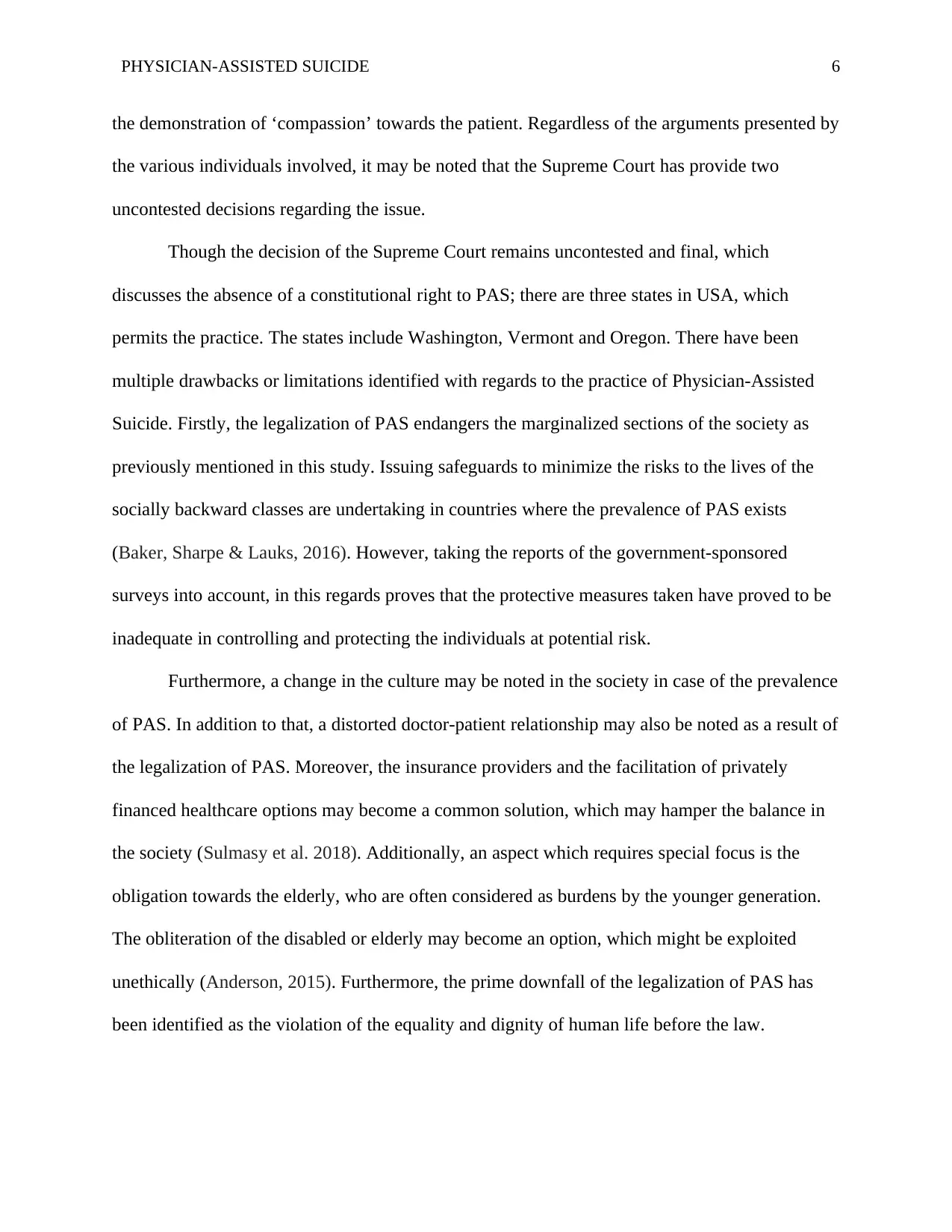
PHYSICIAN-ASSISTED SUICIDE 6
the demonstration of ‘compassion’ towards the patient. Regardless of the arguments presented by
the various individuals involved, it may be noted that the Supreme Court has provide two
uncontested decisions regarding the issue.
Though the decision of the Supreme Court remains uncontested and final, which
discusses the absence of a constitutional right to PAS; there are three states in USA, which
permits the practice. The states include Washington, Vermont and Oregon. There have been
multiple drawbacks or limitations identified with regards to the practice of Physician-Assisted
Suicide. Firstly, the legalization of PAS endangers the marginalized sections of the society as
previously mentioned in this study. Issuing safeguards to minimize the risks to the lives of the
socially backward classes are undertaking in countries where the prevalence of PAS exists
(Baker, Sharpe & Lauks, 2016). However, taking the reports of the government-sponsored
surveys into account, in this regards proves that the protective measures taken have proved to be
inadequate in controlling and protecting the individuals at potential risk.
Furthermore, a change in the culture may be noted in the society in case of the prevalence
of PAS. In addition to that, a distorted doctor-patient relationship may also be noted as a result of
the legalization of PAS. Moreover, the insurance providers and the facilitation of privately
financed healthcare options may become a common solution, which may hamper the balance in
the society (Sulmasy et al. 2018). Additionally, an aspect which requires special focus is the
obligation towards the elderly, who are often considered as burdens by the younger generation.
The obliteration of the disabled or elderly may become an option, which might be exploited
unethically (Anderson, 2015). Furthermore, the prime downfall of the legalization of PAS has
been identified as the violation of the equality and dignity of human life before the law.
the demonstration of ‘compassion’ towards the patient. Regardless of the arguments presented by
the various individuals involved, it may be noted that the Supreme Court has provide two
uncontested decisions regarding the issue.
Though the decision of the Supreme Court remains uncontested and final, which
discusses the absence of a constitutional right to PAS; there are three states in USA, which
permits the practice. The states include Washington, Vermont and Oregon. There have been
multiple drawbacks or limitations identified with regards to the practice of Physician-Assisted
Suicide. Firstly, the legalization of PAS endangers the marginalized sections of the society as
previously mentioned in this study. Issuing safeguards to minimize the risks to the lives of the
socially backward classes are undertaking in countries where the prevalence of PAS exists
(Baker, Sharpe & Lauks, 2016). However, taking the reports of the government-sponsored
surveys into account, in this regards proves that the protective measures taken have proved to be
inadequate in controlling and protecting the individuals at potential risk.
Furthermore, a change in the culture may be noted in the society in case of the prevalence
of PAS. In addition to that, a distorted doctor-patient relationship may also be noted as a result of
the legalization of PAS. Moreover, the insurance providers and the facilitation of privately
financed healthcare options may become a common solution, which may hamper the balance in
the society (Sulmasy et al. 2018). Additionally, an aspect which requires special focus is the
obligation towards the elderly, who are often considered as burdens by the younger generation.
The obliteration of the disabled or elderly may become an option, which might be exploited
unethically (Anderson, 2015). Furthermore, the prime downfall of the legalization of PAS has
been identified as the violation of the equality and dignity of human life before the law.
⊘ This is a preview!⊘
Do you want full access?
Subscribe today to unlock all pages.

Trusted by 1+ million students worldwide
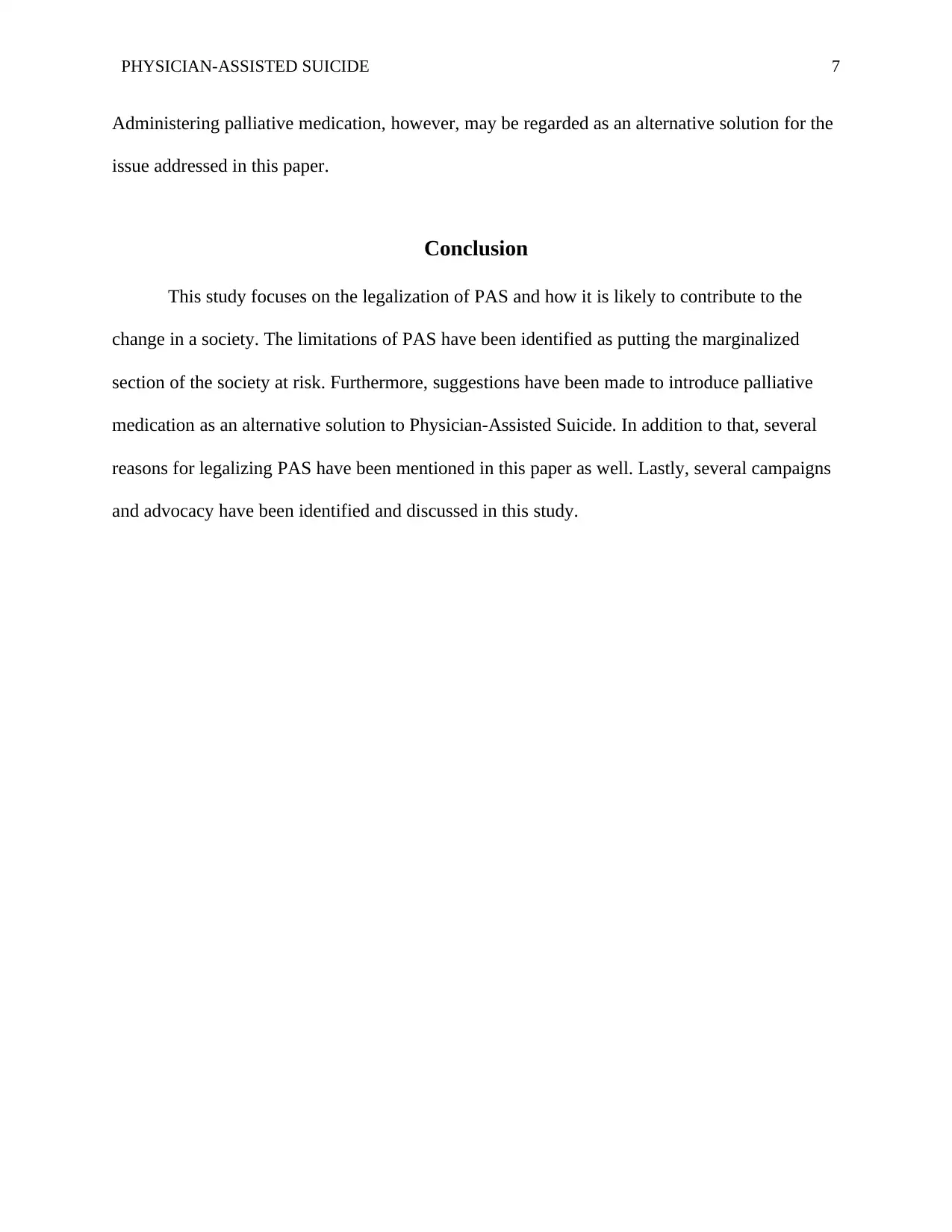
PHYSICIAN-ASSISTED SUICIDE 7
Administering palliative medication, however, may be regarded as an alternative solution for the
issue addressed in this paper.
Conclusion
This study focuses on the legalization of PAS and how it is likely to contribute to the
change in a society. The limitations of PAS have been identified as putting the marginalized
section of the society at risk. Furthermore, suggestions have been made to introduce palliative
medication as an alternative solution to Physician-Assisted Suicide. In addition to that, several
reasons for legalizing PAS have been mentioned in this paper as well. Lastly, several campaigns
and advocacy have been identified and discussed in this study.
Administering palliative medication, however, may be regarded as an alternative solution for the
issue addressed in this paper.
Conclusion
This study focuses on the legalization of PAS and how it is likely to contribute to the
change in a society. The limitations of PAS have been identified as putting the marginalized
section of the society at risk. Furthermore, suggestions have been made to introduce palliative
medication as an alternative solution to Physician-Assisted Suicide. In addition to that, several
reasons for legalizing PAS have been mentioned in this paper as well. Lastly, several campaigns
and advocacy have been identified and discussed in this study.
Paraphrase This Document
Need a fresh take? Get an instant paraphrase of this document with our AI Paraphraser
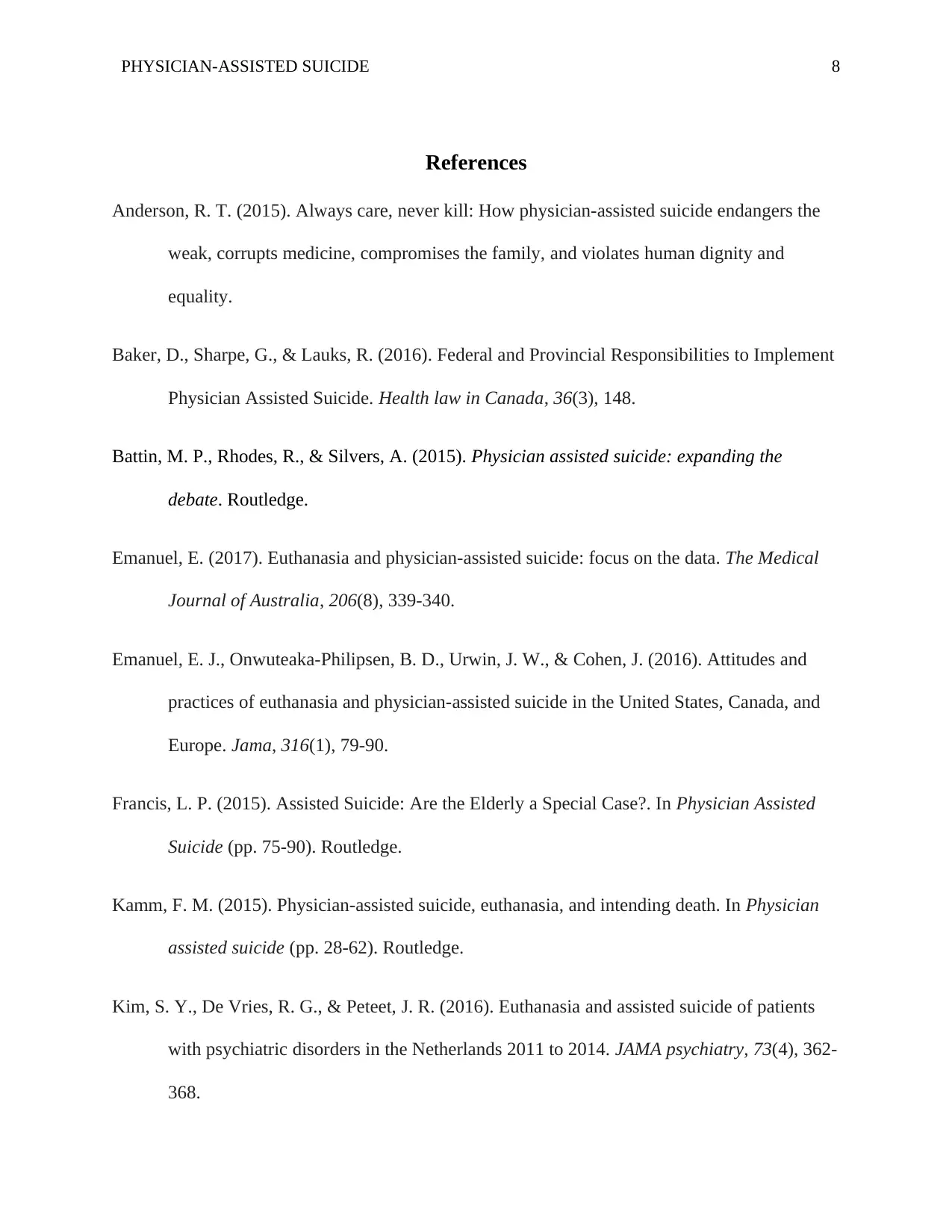
PHYSICIAN-ASSISTED SUICIDE 8
References
Anderson, R. T. (2015). Always care, never kill: How physician-assisted suicide endangers the
weak, corrupts medicine, compromises the family, and violates human dignity and
equality.
Baker, D., Sharpe, G., & Lauks, R. (2016). Federal and Provincial Responsibilities to Implement
Physician Assisted Suicide. Health law in Canada, 36(3), 148.
Battin, M. P., Rhodes, R., & Silvers, A. (2015). Physician assisted suicide: expanding the
debate. Routledge.
Emanuel, E. (2017). Euthanasia and physician-assisted suicide: focus on the data. The Medical
Journal of Australia, 206(8), 339-340.
Emanuel, E. J., Onwuteaka-Philipsen, B. D., Urwin, J. W., & Cohen, J. (2016). Attitudes and
practices of euthanasia and physician-assisted suicide in the United States, Canada, and
Europe. Jama, 316(1), 79-90.
Francis, L. P. (2015). Assisted Suicide: Are the Elderly a Special Case?. In Physician Assisted
Suicide (pp. 75-90). Routledge.
Kamm, F. M. (2015). Physician-assisted suicide, euthanasia, and intending death. In Physician
assisted suicide (pp. 28-62). Routledge.
Kim, S. Y., De Vries, R. G., & Peteet, J. R. (2016). Euthanasia and assisted suicide of patients
with psychiatric disorders in the Netherlands 2011 to 2014. JAMA psychiatry, 73(4), 362-
368.
References
Anderson, R. T. (2015). Always care, never kill: How physician-assisted suicide endangers the
weak, corrupts medicine, compromises the family, and violates human dignity and
equality.
Baker, D., Sharpe, G., & Lauks, R. (2016). Federal and Provincial Responsibilities to Implement
Physician Assisted Suicide. Health law in Canada, 36(3), 148.
Battin, M. P., Rhodes, R., & Silvers, A. (2015). Physician assisted suicide: expanding the
debate. Routledge.
Emanuel, E. (2017). Euthanasia and physician-assisted suicide: focus on the data. The Medical
Journal of Australia, 206(8), 339-340.
Emanuel, E. J., Onwuteaka-Philipsen, B. D., Urwin, J. W., & Cohen, J. (2016). Attitudes and
practices of euthanasia and physician-assisted suicide in the United States, Canada, and
Europe. Jama, 316(1), 79-90.
Francis, L. P. (2015). Assisted Suicide: Are the Elderly a Special Case?. In Physician Assisted
Suicide (pp. 75-90). Routledge.
Kamm, F. M. (2015). Physician-assisted suicide, euthanasia, and intending death. In Physician
assisted suicide (pp. 28-62). Routledge.
Kim, S. Y., De Vries, R. G., & Peteet, J. R. (2016). Euthanasia and assisted suicide of patients
with psychiatric disorders in the Netherlands 2011 to 2014. JAMA psychiatry, 73(4), 362-
368.
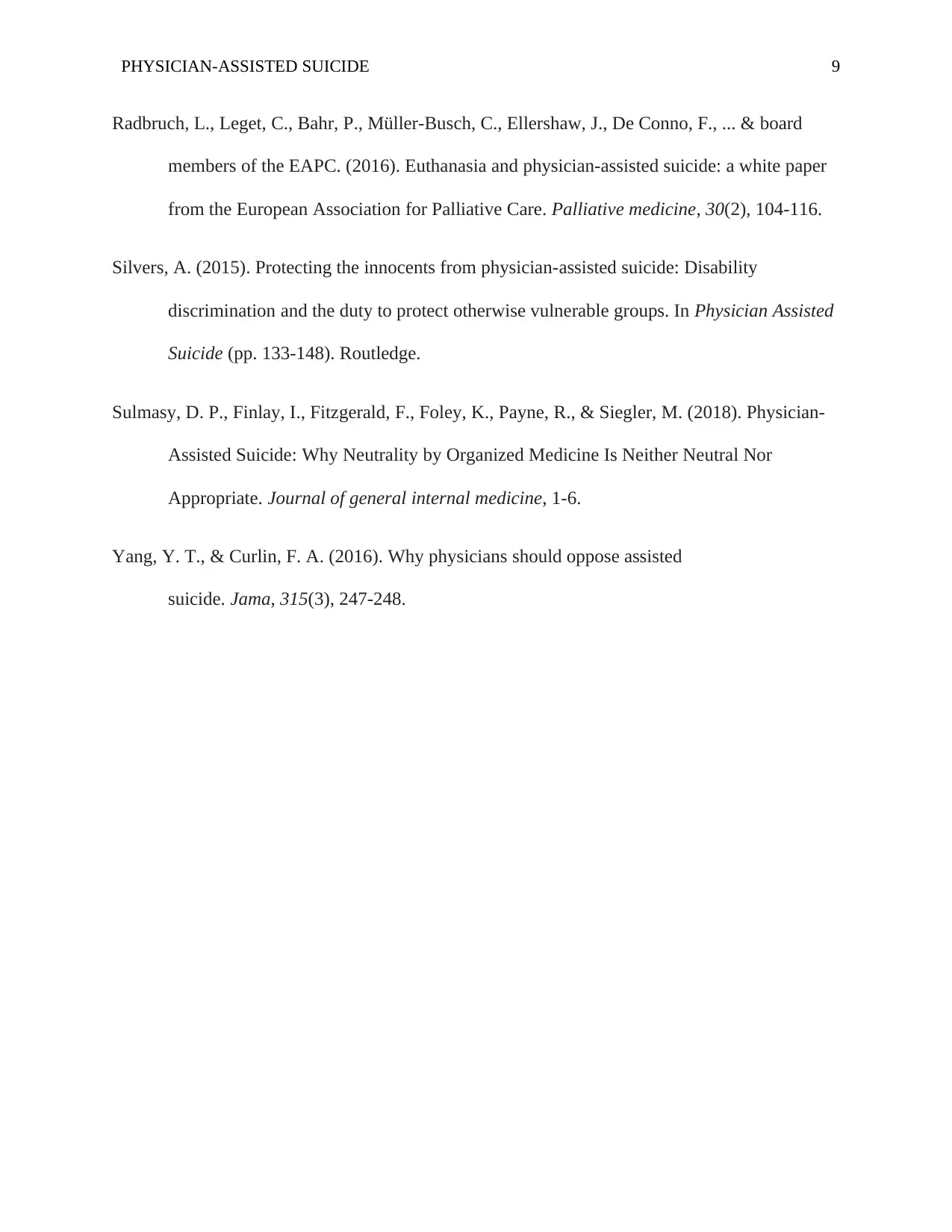
PHYSICIAN-ASSISTED SUICIDE 9
Radbruch, L., Leget, C., Bahr, P., Müller-Busch, C., Ellershaw, J., De Conno, F., ... & board
members of the EAPC. (2016). Euthanasia and physician-assisted suicide: a white paper
from the European Association for Palliative Care. Palliative medicine, 30(2), 104-116.
Silvers, A. (2015). Protecting the innocents from physician-assisted suicide: Disability
discrimination and the duty to protect otherwise vulnerable groups. In Physician Assisted
Suicide (pp. 133-148). Routledge.
Sulmasy, D. P., Finlay, I., Fitzgerald, F., Foley, K., Payne, R., & Siegler, M. (2018). Physician-
Assisted Suicide: Why Neutrality by Organized Medicine Is Neither Neutral Nor
Appropriate. Journal of general internal medicine, 1-6.
Yang, Y. T., & Curlin, F. A. (2016). Why physicians should oppose assisted
suicide. Jama, 315(3), 247-248.
Radbruch, L., Leget, C., Bahr, P., Müller-Busch, C., Ellershaw, J., De Conno, F., ... & board
members of the EAPC. (2016). Euthanasia and physician-assisted suicide: a white paper
from the European Association for Palliative Care. Palliative medicine, 30(2), 104-116.
Silvers, A. (2015). Protecting the innocents from physician-assisted suicide: Disability
discrimination and the duty to protect otherwise vulnerable groups. In Physician Assisted
Suicide (pp. 133-148). Routledge.
Sulmasy, D. P., Finlay, I., Fitzgerald, F., Foley, K., Payne, R., & Siegler, M. (2018). Physician-
Assisted Suicide: Why Neutrality by Organized Medicine Is Neither Neutral Nor
Appropriate. Journal of general internal medicine, 1-6.
Yang, Y. T., & Curlin, F. A. (2016). Why physicians should oppose assisted
suicide. Jama, 315(3), 247-248.
⊘ This is a preview!⊘
Do you want full access?
Subscribe today to unlock all pages.

Trusted by 1+ million students worldwide
1 out of 9
Related Documents
Your All-in-One AI-Powered Toolkit for Academic Success.
+13062052269
info@desklib.com
Available 24*7 on WhatsApp / Email
![[object Object]](/_next/static/media/star-bottom.7253800d.svg)
Unlock your academic potential
Copyright © 2020–2025 A2Z Services. All Rights Reserved. Developed and managed by ZUCOL.





